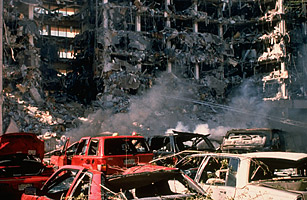
April 19, 1995
No one noticed the smoke seeping from the windows of the rental truck as Timothy McVeigh pulled up to the Alfred P. Murrah Federal Building that gray morning. McVeigh had lit two fuses to the 7,000 lb. fertilizer bomb in the truck and then parked it beside the building's day-care center. The explosion vaporized the front of the building, leaving a yawning cross-section of oozing cable and smoke. The dead would number 168, including 19 children. (At least six people who survived or lost loved ones in the bombing have since killed themselves.) When McVeigh was executed in 2001, the former Gulf War soldier remained convinced that his deadly deed had punished the U.S. government for its 1993 siege of the Branch Davidian compound near Waco, Texas.
For America, the bombing was an introduction to mass-casualty terrorism. The enemy was no longer uniformed platoons but lone extremists in our midst. They could not be easily ferreted out — or understood. But Oklahoma City also wrote the book on recovery. The survivors have become indispensable companions for the families of 9/11 victims. And the memorial to the homegrown tragedy shows that traumatized cities can unite, as author Edward Linenthal puts it, "to protest the anonymity of mass death."